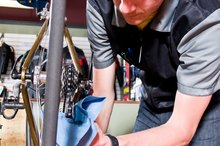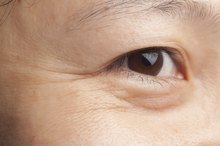What Gets Medical Tape Adhesive Off Skin?
Medical professionals use strips of strong, impermeable tape to hold sterile gauze pads in place, effectively covering wounds and protecting them while they heal. Once removed from the skin, the tape tends to leave a sticky, black residue behind. This gummy adhesive does not wash away with soap and water; however, it can be easily dissolved with a variety of skin-safe solvents.
Isopropyl Alcohol
Isopropyl alcohol, or rubbing alcohol, is a popular solvent that can dissolve a range of bonding agents. The chemicals in the alcohol break down glue, releasing the adhesive from the surface. To remove medical tape residue, moisten a cotton ball with 70 percent isopropyl alcohol and rub it briskly over any affected areas of the skin. Use small, circular motions to loosen stubborn tape deposits, then rinse with cool water and repeat if necessary. Do not use this method near an open wound; exposure to alcohol will cause an extremely unpleasant burning sensation.
- Isopropyl alcohol, or rubbing alcohol, is a popular solvent that can dissolve a range of bonding agents.
- Use small, circular motions to loosen stubborn tape deposits, then rinse with cool water and repeat if necessary.
Shampoo
How to Remove Medical Tape Glue
Learn More
Ordinary shampoo is an old-fashioned remedy for painlessly removing sticky gunk from the skin. Simply smear a thick layer of shampoo over any persistent tape residue, then cover the area with a damp cloth. Wait 10 minutes and rub the skin gently to remove any lingering traces of gummy adhesive; rinse well and repeat if necessary. While this method may take several application to completely remove the residue, it is painless, inexpensive and safe for sensitive skin.
- Ordinary shampoo is an old-fashioned remedy for painlessly removing sticky gunk from the skin.
- Wait 10 minutes and rub the skin gently to remove any lingering traces of gummy adhesive; rinse well and repeat if necessary.
Oil
Get rid of leftover adhesive marks from bandages by rubbing them away with oil. Dab a cotton ball in bath oil, baby oil, mineral oil or vegetable oil, and swab it over the sticky residue. The compounds in the oil soften the glue, easing its removal from the skin. This method can also be used to eliminate--or at least significantly reduce--the sting that inevitably accompanies the removal of a bandage. Rub oil around the edges of the bandage and let it seep through the air holes until the material begins to loosen. Add more oil if necessary, working the bandage loose until it slides painlessly from the skin.
- Get rid of leftover adhesive marks from bandages by rubbing them away with oil.
- Rub oil around the edges of the bandage and let it seep through the air holes until the material begins to loosen.
Petroleum Jelly
How to Clear Up Ingrown Hairs
Learn More
Petroleum jelly is one of those household oddities. No one knows exactly what to do with it, but no medicine cabinet is complete without it. As the name suggests, it is a petroleum-based product. As petrochemical, it effectively dissolves a number of tacky substances, but in gel form, it is safe for use on the skin--even near the eyes. To remove medical tape adhesive, apply a thick layer of petroleum jelly to the affected areas 3. Wait 30 minutes, then rub the skin gently until the glue disintegrates. Wipe with a wet cloth to rinse and repeat if necessary.
- Petroleum jelly is one of those household oddities.
- As petrochemical, it effectively dissolves a number of tacky substances, but in gel form, it is safe for use on the skin--even near the eyes.
Related Articles
References
- "The Queen of Clean's Complete Cleaning Guide"; Linda Cobb; 2002
- "Extraordinary Uses for Ordinary Things"; Marylin Bader, et al; 2005
- Quick Medical: Material Safety Data Sheet- Adhesive Tape Remover Pads
Writer Bio
Lisa Parris is a writer and former features editor of "The Caldwell County News." Her work has also appeared in the "Journal of Comparative Parasitology," "The Monterey County Herald" and "The Richmond Daily News." In 2012, Parris was honored with awards from the Missouri Press Association for best feature story, best feature series and best humor series.







